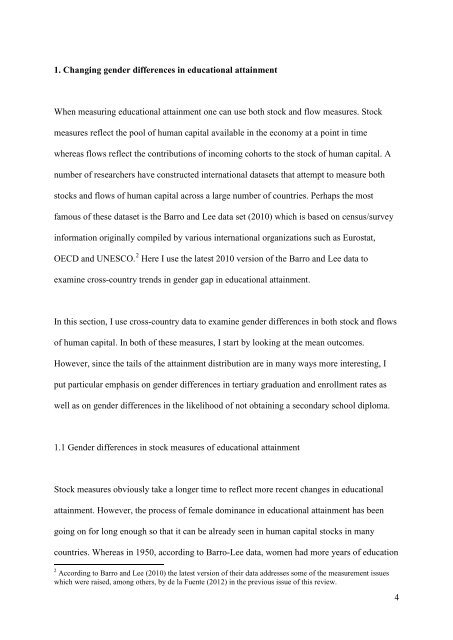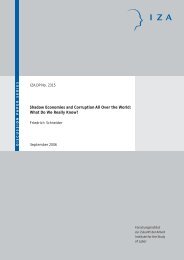Gender Differences in Education Tuomas Pekkarinen - Index of - IZA
Gender Differences in Education Tuomas Pekkarinen - Index of - IZA
Gender Differences in Education Tuomas Pekkarinen - Index of - IZA
Create successful ePaper yourself
Turn your PDF publications into a flip-book with our unique Google optimized e-Paper software.
1. Chang<strong>in</strong>g gender differences <strong>in</strong> educational atta<strong>in</strong>ment<br />
When measur<strong>in</strong>g educational atta<strong>in</strong>ment one can use both stock and flow measures. Stock<br />
measures reflect the pool <strong>of</strong> human capital available <strong>in</strong> the economy at a po<strong>in</strong>t <strong>in</strong> time<br />
whereas flows reflect the contributions <strong>of</strong> <strong>in</strong>com<strong>in</strong>g cohorts to the stock <strong>of</strong> human capital. A<br />
number <strong>of</strong> researchers have constructed <strong>in</strong>ternational datasets that attempt to measure both<br />
stocks and flows <strong>of</strong> human capital across a large number <strong>of</strong> countries. Perhaps the most<br />
famous <strong>of</strong> these dataset is the Barro and Lee data set (2010) which is based on census/survey<br />
<strong>in</strong>formation orig<strong>in</strong>ally compiled by various <strong>in</strong>ternational organizations such as Eurostat,<br />
OECD and UNESCO. 2<br />
Here I use the latest 2010 version <strong>of</strong> the Barro and Lee data to<br />
exam<strong>in</strong>e cross-country trends <strong>in</strong> gender gap <strong>in</strong> educational atta<strong>in</strong>ment.<br />
In this section, I use cross-country data to exam<strong>in</strong>e gender differences <strong>in</strong> both stock and flows<br />
<strong>of</strong> human capital. In both <strong>of</strong> these measures, I start by look<strong>in</strong>g at the mean outcomes.<br />
However, s<strong>in</strong>ce the tails <strong>of</strong> the atta<strong>in</strong>ment distribution are <strong>in</strong> many ways more <strong>in</strong>terest<strong>in</strong>g, I<br />
put particular emphasis on gender differences <strong>in</strong> tertiary graduation and enrollment rates as<br />
well as on gender differences <strong>in</strong> the likelihood <strong>of</strong> not obta<strong>in</strong><strong>in</strong>g a secondary school diploma.<br />
1.1 <strong>Gender</strong> differences <strong>in</strong> stock measures <strong>of</strong> educational atta<strong>in</strong>ment<br />
Stock measures obviously take a longer time to reflect more recent changes <strong>in</strong> educational<br />
atta<strong>in</strong>ment. However, the process <strong>of</strong> female dom<strong>in</strong>ance <strong>in</strong> educational atta<strong>in</strong>ment has been<br />
go<strong>in</strong>g on for long enough so that it can be already seen <strong>in</strong> human capital stocks <strong>in</strong> many<br />
countries. Whereas <strong>in</strong> 1950, accord<strong>in</strong>g to Barro-Lee data, women had more years <strong>of</strong> education<br />
2 Accord<strong>in</strong>g to Barro and Lee (2010) the latest version <strong>of</strong> their data addresses some <strong>of</strong> the measurement issues<br />
which were raised, among others, by de la Fuente (2012) <strong>in</strong> the previous issue <strong>of</strong> this review.<br />
4
















